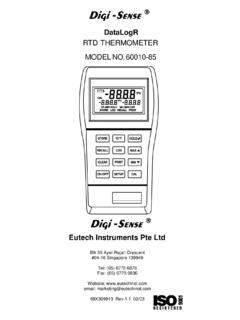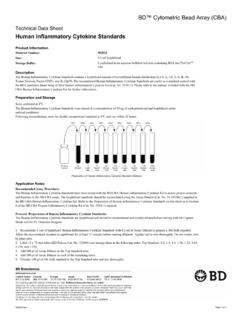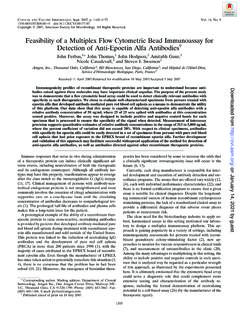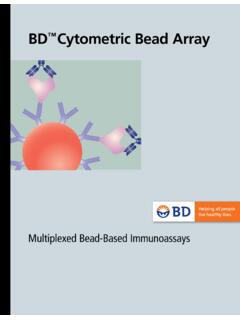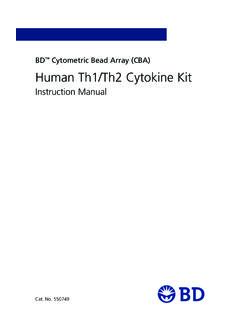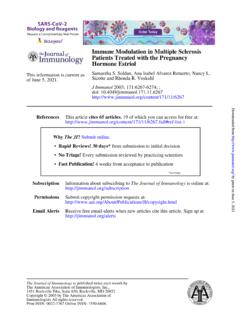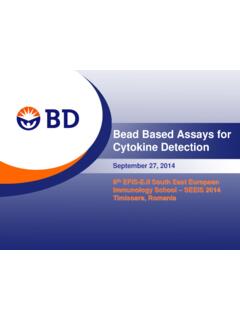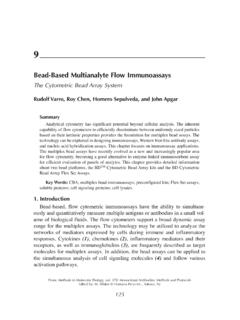Transcription of Novel multicolor flow cytometry tools for the …
1 T-Cell ResearchNovel multicolor flow cytometry tools for the study of CD4+ T-cell differentiation and 17/16/10 9:14:51 27/16/10 9:14:55 AM3T cells have become a dynamic area of research. Among the methods used to characterize this major lymphocyte subset, multicolor flow cytometry is preeminent. Additionally, the complexity of the CD3+ T-cell population both functionally and phenotypically makes multiparametric flow cytometry a necessary and powerful platform. For more than two decades, researchers have made thousands of advances in T-cell study using BD flow cytometry products. And many of today s discoveries involving T cells also involve BD Biosciences platforms, reagents, instruments,and protocols. BD continues to build on this commitment with new, quality reagents and kits, including IL-17F and T-bet monoclonal antibodies, Th17/Treg phenotyping kits, the Regulatory T Cell Sorting Kit, Th1/Th2/Th17 CBA kits, and theBD Phosflow T Cell Activation Kit.
2 T-cell subtypes can be defined by the combinations of cell surface markersand transcription factors they express and the cytokines they secrete. These proteins are regulated through signaling pathways. For example, the bindingof IL-6 to its receptor leads to the phosphorylation of Stat3, which can thenlead to the expression of plasticity, the ability of a cell to change its phenotype in response to its environment, is of particular interest especially for Th17 and regulatoryT cells. This brochure discusses and demonstrates how the following platformscan be used to study T-cell differentiation:Cell Surface Markers to identify cells from heterogenous samples Intracellular Cytokine Staining (ICS) to measure cytokines within individual cellsBD Phosflow technology to measure the phosphorylation of key proteinsBD cytometric Bead array (CBA) to measure secreted cytokines within a sampleBD Biosciences continuously updates our portfolio of products for the analysisand enrichment of T cells.
3 BD Biosciences reagents are backed by a world-class service and support organization to help customers take full advantage of our products to advance their research. Comprehensive services include technical application support and customer assay services provided by experiencedscientific and technical Solid Commitment to Research: Flexible Ways to Study CD4 T-Cell Differentiation and PlasticityFor Research Use Only. Not for use in diagnostic or therapeutic 37/16/10 9:14:59 AM4T Cells: An OverviewSummary of T-cell SubsetsT cells can be separated into three major groups based on function: cytotoxic T cells, helper T cells (Th), and regulatory T cells (Tregs). Differential expression of markers on the cell surface, as well as their distinct cytokine secretion profiles, provide valuable clues to the diverse nature and function of T example, CD8+ cytotoxic T cells destroy infected target cells through the release of perforin, granzymes, and granulysin, whereas CD4+ T helper cells (ie, Th1, Th2, Th9, Th17, and Tfh cells) have little cytotoxic activity and secrete cytokines that act on other leucocytes such as B cells, macrophages, eosinophils, or neutrophils to clear pathogens.
4 Tregs suppress T-cell function by several mechanisms including binding to effector T-cell subsets and preventing secretion of their cytokines. To support the use of multicolor flow cytometry for the study of T cells, BD offers a deep portfolio of reagents, which are highlighted in red in the table below. BD now also offers more choice. Many of these specificities are available in multiple formats including BD Horizon V450 and V500 formats for use with the violet : Essential Regulators of Immunity Tregs play an important role in maintaining immune homeostasis and have also been implicated in a number of autoimmune Flow cytometry is a particularly useful application for the sorting and analysis of Tregs. Two major classes of CD4+ Tregs have been identified to date: natural Tregs (nTregs) that constitutively express CD25 and FoxP3, and adaptive or inducible Tregs (iTregs) in which CD25 and FoxP3 expression is CD25 expression differs between human and mouse Tregs.
5 In mice all CD25+ cells are considered Tregs, compared to humans, for whom only those cells expressing the highest levels of CD25 are considered to be This table summarizes major known T-cell markers. Markers can be altered as a result of cellular environment, differentiation state, and other factors. Key cytokines appear in bold. BD Biosciences offers reagents for molecules in dynamic area of researchType of CellCytotoxicTh1Th2Th92Th17 Tfh3 Tre gMain FunctionKill virus-infected cellsActivate microbicidal function of infected macrophages, and help B cells to produce antibodyHelp B cells and switch antibody isotype productionT cell proliferation and enhanced IgG and IgE production by B cellsEnhance neutrophil responseRegulate development of antigen specifi c B cell development and antibody productionImmune regulation Pathogens TargetedViruses and some intracellular bacteriaIntracellular pathogensParasitesParasitesFungi and extracellular bacteriaHarmful FunctionTransplant rejectionAutoimmune diseaseAllergy, asthmaAllergyOrgan-specifi c autoimmune diseaseAutoimmune diseaseAutoimmune disease, cancerExtracellular MarkersCD8CD4 CXCR3CD4 CCR4, Crth2 (human)
6 CD4CD4, CCR6CD4, CXCR5CD4, CD25 Differentiation CytokinesIFN- , IL-2, IL-12, IL-18, IL-27IL-4, IL-2, IL-33IL-4, TGF- TGF- , IL-6, IL-1, IL-21, IL-23IL-12, IL-6 TGF- , IL-12 Effector CytokinesIFN- , TNF, LT- IFN- , LT- , TNFIL-4, IL-5, IL-6, IL-13IL-9, IL-10IL-17A, IL-17F, IL-21, IL-22, IL-26, TNF, CCL20IL-21 TGF- , IL-10 Transcription FactorsT-bet, Stat1, Stat6 GATA3, Stat5, Stat6 GATA3, Smads, Stat6 ROR t, ROR , Stat3 Bcl-6, MAFFoxP3, Smad3, Stat5 For Research Use Only. Not for use in diagnostic or therapeutic 47/16/10 9:15:02 AMDIFFERENTIATION5 Four-color analysis of the expression of CD4, CD25, CD127, and CD45RA on sorted peripheral blood mononuclear cells (PBMCs). PBMCs were stained with the BD Human Regulatory T Cell Sorting Kit (Cat. No. 560753) and then sorted on a BD FACSAria cell sorter. Lymphocytes were identifi ed by light scatter profi le and CD4+ expression and sorted for CD4 Treg profi le (panel A).
7 The CD45RA negative and positive fractions (data not shown) were sorted, then separately expanded. Fractions were stained with isotype control (Cat. No. 557732) and conjugated anti-human FoxP3 monoclonal antibody (Cat. No. 560045).A Data representing the CD25 and CD127 expression profi le of the CD4 positive cells prior to gating on CD45RA populations for Data showing hFoxP3 expression on sorted CD25high CD127low Tregs (blue solid histogram) and isotype control (dashed line) for the CD45RA+ and CD45RA- fractions, respectively. Acquisition and analysis were performed on a BD LSR II or inducible Tregs originate from the thymus as single-positive CD4 cells. They differentiate into CD25 and FoxP3 expressing Tregs following adequate antigenic stimulation in the presence of cognate antigen and specialized immunoregulatory cytokines such as TGF- , IL-10, and IL-2. The iTreg population is also reported to be more plastic, with the ability to convert to other T-cell subtypes such as Th1 and Th17 FoxP3 is currently the most definitive marker for Tregs, although there have been reports of small populations of FoxP3- Tregs.
8 The discovery of the transcription factor FoxP3 as a marker for Tregs has allowed scientists to better define these populations, leading to the discovery of additional Treg markers, including CD127. Several published reports in addition to data generated at BD have demonstrated that CD127 expression is inversely correlated with ,8 The sorting strategy of collecting CD4+, CD25+, and CD127- cellsis useful for obtaining viable, expandable PECD127 Alexa Fluor Fluor 647 hFoxP3 Relative Cell Number102101100103104020406080100 Alexa Fluor 647 hFoxP3 Relative Cell Number102101100103104020406080100 BAEnrichment of TregsStudies by Miyara9,10 and Hoffmann11 have found that CD45RA is a useful marker to identify and isolate na ve Treg subpopulations. CD45RA+ Tregs may be less plastic, maintaining FoxP3 status, post-expansion. CD45RA antibodies are an optimized drop-in in BD Biosciencesnew sorting the experiment below, the CD45RA+ Treg subpopulation(left histogram, solid blue) showed no tendency to lose its FoxP3 expression.
9 However, unexpectedly, the CD45RA- Treg subpopulation (right histogram) did show reduced expression of FoxP3 in some cells. Further research is needed to explore these Treg Research Use Only. Not for use in diagnostic or therapeutic 57/16/10 9:15:03 AM6 Measure one secreted cytokinewith ELISA or ELISPOTE xamine cytokines expressed from a particular cell type with intracellular flow cytometryUse flow cytometry to sort cells orexamine expression of cell surface markersUse BrdU, Annexin V, and other methodsto examine proliferation and apoptosisMeasure phosphorylation status of keyproteins with BD Phosflow antibodiesUse optimized buffers andantibodies to look at transcriptionfactor expression by flow cytometryMeasure the levels of severalcytokines simultaneously with BD CBAD onor variability caused by factors such as differences in age or antigen exposure can contribute significantly to heterogeneity in peripheral lymphoid cell populations, including those found in peripheral blood.
10 BD s comprehensive portfolio of reagents includes products for surface marker analysis for phenotyping cells, and for intracellular flow cytometry for detecting effector molecules (such as cytokines and chemokines) and cell signaling molecules (such as transcription factors and phosphorylated proteins).BD also provides optimized buffers, fluorescent antibody cocktails, and kits combining surface staining with intracellular flow cytometry to enable researchers to maximize the information obtained from analysis of individual variety of tools from BD allow the detailed study of cell products facilitate the detection of cell surface markers, phosphorylated proteins, transcription factors, apoptosis markers, and cytokines. Secreted cytokines can be measured with ELISA or ELISPOT for single cytokines or by BD CBA for multiplexed assays to measure several cytokines in the same well. Using these techniques, researchers can learn the percentage of a certain type of cell along with its activation status, allowing the effect of minute changes (in protein phosphorylation status, cytokine levels, etc) to be determined within populations of tools to support and streamline T-cell researchTools and Techniques for T-cell AnalysisTool/TechnologyFlow cytometry /SurfaceFlow cytometry /IntracellularBD cytometric Bead array (CBA)ELISPOTELISAIn Vivo Capture AssayMolecules detectedSurfaceIntracellular and surfaceSecreted or intracellularSecreted (in situ)SecretedSecreted (in vivo)
